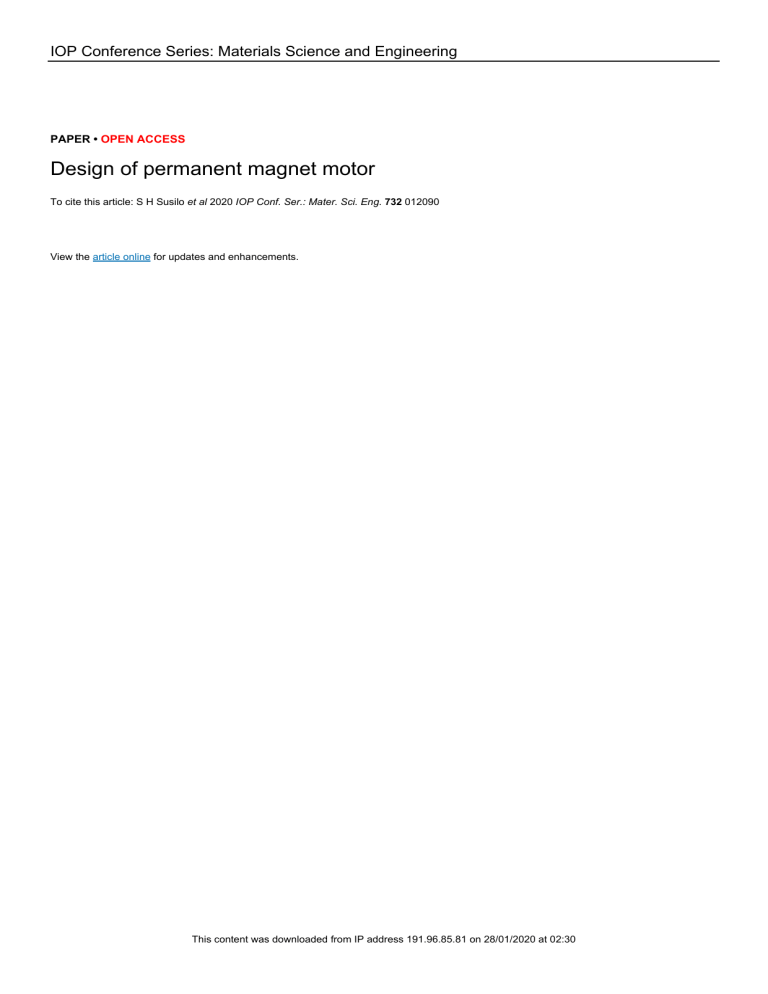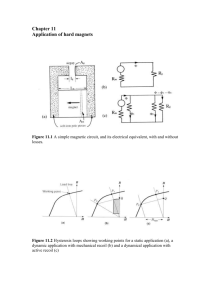
IOP Conference Series: Materials Science and Engineering PAPER • OPEN ACCESS Design of permanent magnet motor To cite this article: S H Susilo et al 2020 IOP Conf. Ser.: Mater. Sci. Eng. 732 012090 View the article online for updates and enhancements. This content was downloaded from IP address 191.96.85.81 on 28/01/2020 at 02:30 The 1st Annual Technology, Applied Science and Engineering Conference IOP Publishing IOP Conf. Series: Materials Science and Engineering 732 (2020) 012090 doi:10.1088/1757-899X/732/1/012090 Design of permanent magnet motor S H Susilo1,*, Z Jannah1, L D Mustofa2 and Y Effendhi1 1 Mechanical Engineering Department Polytechnic State of Malang, Malang, Indonesia 2 Electrical Engineering Department Polytechnic State of Malang, Malang, Indonesia *shadis172.gh@gmail.com Abstract. The increasing energy demand is in line with population growth as well as the development of science and technology, and the maximum utilization of energy derived from magnets. The purpose of this research is to design of permanent magnet motor that produces rotation that can be utilized as power plant propulsion, without using fuel oil. The method used is to examine and search the gap of existing patent design and develop it in the form of a new design, In the hope of increasing the potential of magnetic energy into a magnetic power plant. By designing the magnetic position and angle of attack on the rotor and stator motor magnet. 1. Introduction Increased energy needs in line with population growth and the development of science and technology, encourage to develop renewable energy. The study was conducted to anticipate a shortage of energy resources. So that new innovation is needed. one example, magnetic energy was developed which is used as a generator driving motor. This motor utilizes magnetic force as energy, resulting in rotation. The several Asian countries, Europe and America have developed power plants from renewable energy sources (water, wind and solar). it is done as a form of anticipation of the depletion of energy petroleum and natural gas reserves. the use of magnetic technology has increasingly simplified and expanded its application, especially the optimization of energy generation systems it [1]. 2. Permanent magnet motor The magnetic motor consists of several permanent magnets arranged as rotor and stator. There is a pulling force and consistently rejects between them, causing the rotor to rotate. 2.1. Shenhe Wang's permanent magnet motor Patrick J. Kelly stated that Shen Wang made a power generator with a capacity of five kilowatts. This generator uses a permanent magnet so it doesn't use fuel. it's designed as shown in figure 1 [2]. Content from this work may be used under the terms of the Creative Commons Attribution 3.0 licence. Any further distribution of this work must maintain attribution to the author(s) and the title of the work, journal citation and DOI. Published under licence by IOP Publishing Ltd 1 The 1st Annual Technology, Applied Science and Engineering Conference IOP Publishing IOP Conf. Series: Materials Science and Engineering 732 (2020) 012090 doi:10.1088/1757-899X/732/1/012090 Figure 1. Shenhe Wang's permanent magnet motor design. 2.2. John W. Ecklins magnetic shielding generator John W. Ecklin has patented a magnetic motor. In his patent, a magnet motor/generator produces large output from a small input. it's designed as shown in figure 2 [3]. Figure 2. Permanent magnet motor design John W Ecklins. The low-power motors are used to rotate magnetic insulation that covers two magnets that attract each other. it causes the magnetic field to fluctuate and it used to rotate the drive generator. 2.3. Johnson is Johnson's permanent magnet motorcycle On April 24, 1979 Johnson Howard R has patented a permanent magnet motor, the magnetic material used is a samarium cobalt magnet with a configuration design like figure 3 [4]. 2 The 1st Annual Technology, Applied Science and Engineering Conference IOP Publishing IOP Conf. Series: Materials Science and Engineering 732 (2020) 012090 doi:10.1088/1757-899X/732/1/012090 Figure 3. Howard Johnson's permanent magnet motor design. The point is that he made that the magnetic flux of this motor remains balanced, resulting in a continuous rotating rotation. The magnetic motor is mounted on a non-magnetic shaft. The magnetic regulator is placed in a mu-metal cylinder. Mu-metal is very conductive for magnetic flux. 2.4. Tracy Robert permanent magnet motor On November 21, 1972, Derouin David J and Tacy Robert obtained a patent for a magnetic motor. The working principle of the magnetic motor uses a magnetic shield that is placed between a pair of permanent magnets at the motor shaft. it's designed as shown in figure 4 [5]. Figure 4. Robert Tracy's permanent magnet motor design. 2.5. Ben teal electromagnetic motor In June 1978, Ben patented a magnetic motor with construction with wood material and magnet. it's designed as shown in figure 5 [6]. 3 The 1st Annual Technology, Applied Science and Engineering Conference IOP Publishing IOP Conf. Series: Materials Science and Engineering 732 (2020) 012090 doi:10.1088/1757-899X/732/1/012090 Figure 5. Ben Teal's Permanent Magnet Motor Design. The working principle of a magnetic motor is by setting four metal plates, driven by a cam on the rotor shaft. Each plate has electromagnetic power when pulling and breaking electromagnetic forces. f. Jones Permanent Magnet Motor. The design of this motor uses magnets to produce continuous strength in one direction. With the arrangement of magnets like figure 6 [7]. Figure 6. Design of permanent magnetic motor Jines. 2.6. Charles "Joe" Flynn's permanent magnet motor This finding is related to the method of producing energy with magnetism as a driving force. The construction of the magnet motor proposed as shown in figure 7 [8]. 4 The 1st Annual Technology, Applied Science and Engineering Conference IOP Publishing IOP Conf. Series: Materials Science and Engineering 732 (2020) 012090 doi:10.1088/1757-899X/732/1/012090 Figure 7. Design of permanent magnet motor Charles "Joe" Flynn's. The construction is relatively simple, the thrust force comes from three magnets, indicated shade in blue and yellow. the lower magnet position in the form of a disk. the immovable stator magnet is located on a disk made of non-magnetic material (gray shade) and which has two magnets embedded in it. This disk is a rotor and it's attached to a central vertical shaft. Usually, the rotor will not rotate, but between the two discs, there is a seven coil ring which is used to modify the magnetic field and produce strong rotation. In the 1980s, China discovered magnetic field technology and succeeded in making a free-energy device that had a unit measuring 150cm x 120cm x 80cm that could produce approximately 5 KW of power. The workings of this free-energy engine only use magnets as the main driving force, these devices without batteries, without electricity, and without any fuel, can move continuously at high speed, are stable and very strong in their driving force or attraction, so that able to play an electric dynamo with a power of 1000 watts to 5000 watts. Robert A. Nelson has developed electric motors, generators, and heaters that operate on permanent magnets. One device absorbs 100 watts of electricity from the source, and produces 100 watts to recharge the source, and produces heat in an amount of more than 140 BTUs in two minutes [9]. Thomas E. Bearden, et.al. has made two permanent magnet-powered electric transformer models. The device uses 6 watts of the electrical input to control the magnetic field path that comes out of a permanent magnet. By channeling the magnetic field, first on the output coil than on the output coil, second by doing this continues to produce 96 watts of electrical output without any moving parts. Bearden referred to the device as a Moving Electromagnetic Generator (MEG), or in other words a stationary magnetic generator. He has duplicated a tool made by Bearden in France. The basic principle of this tool was first revealed by Frank Richardson of the United States in 1978. He made a special magnetic fan model which became hot when the fan turned. The device absorbs the same amount of energy to rotate the fan, whether it produces heat or not [10]. 3. Design magnet motor The object of this design is to improve the output power efficiency of the motor that utilizes the permanent magnet. A motor permanent magnet has two main parts, namely the moving field and the fixed field. The magnetic motor power is generated by a permanent magnet which is placed on three fields (outer diameter, right side, and left side) which move with three fixed fields. The output power is generated from the repulsion force and pulls force between the permanent magnet which is in the movable field with the two fields that are beside and cover the field. The output power indicated by the motor rotation produced. The rotation of the permanent magnet motor is produced from three sides of the field, namely: The repulsion force and pull between the permanent magnet which is in the plane of the cylinder moves with the permanent magnet on the two side fields (right side and left side). The repulsion force and pulls between the permanent magnet which is in the outer diameter of the moving cylindrical field and the permanent magnet on the inner diameter. 5 The 1st Annual Technology, Applied Science and Engineering Conference IOP Publishing IOP Conf. Series: Materials Science and Engineering 732 (2020) 012090 doi:10.1088/1757-899X/732/1/012090 To control the rotation of the motor using a screw so that it can to set a gap between the casing and the moving cylinder. Complete magnetic motor rotor 1 Rotor 2 stator 1 Stator 2 stator 3 Figure 8. Design magnetic motor. 4. Conclusion In the hope of increasing the potential of magnetic energy into a magnetic power plant. By designing the magnetic position and angle of attack on the rotor and stator motor magnet. Acknowledgment Thanks to the Directorate of Research and Community Service (DRPM) Directorate-General for Research and Development at the Ministry of Research, Technology and Higher Education who has provided funding support to this research by DIPA 2019 funds, Malang State Polytechnic. References [1] Marsudi D 2005 Pembangkitan Energi Listrik (Jakarta: Erlangga) 2 [2] Patrick J K 2010 practical guide to free energy device [3] John W Ecklin Paten US 3879622 A Permanent magnet motion conversion device. [4] Johnson H R Paten US 4151431 A Permanent magnet motor [5] Derouin D J and Tacy R D Paten US 3703653 A Reciprocating motor with motion conversion means [6] Ben Teal’s Electromagnet Motor Paten US 4,093,880 A Automatic transmitter key for distress signals. [7] Jines J E and Jines J W Paten US 3469130 A Means for shielding and unshielding permanent magnets and magnetic motors utilizing same. [8] Charles “Joe” Flynn’s Permanent Magnet Motor Paten US 5,455,474 A Novel gene disruptions, compositions and methods relating thereto [9] Robert A N 2009 Han's Coler's "Free Energy" Generators [10] Thomas E B Paten US 6362718 Motionless Electromagnetic Generator bered section of the paper. 6

